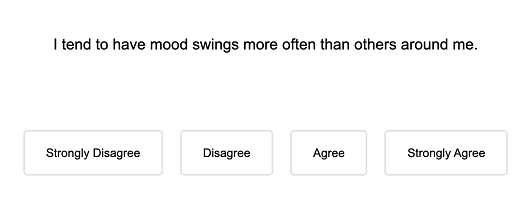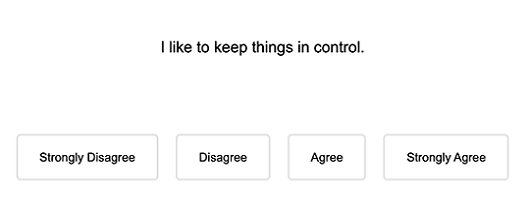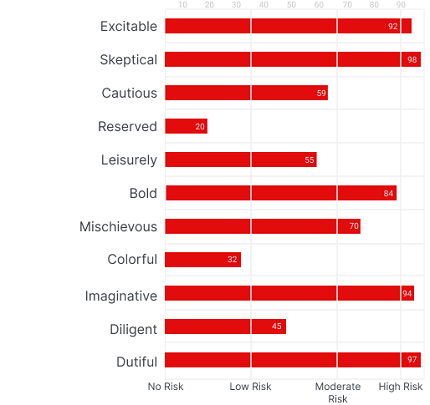 The Hogan Development Survey
The Hogan Development Survey
Taking the Hogan Development Survey (HDS) assessment?
The Hogan Development Survey is a personality questionnaire aimed to measure how you would behave under stress, and specifically what personality tendencies could damage your job performance.
On this page, we will go over everything you should expect on the tricky HDS test, including Sample Questions, Answers & Tips.
What Is The Hogan Development Survey (HDS)
The Hogan Development Survey (HDS) is one of the Hogan Assessments, used to evaluate whether you have the required characteristics to succeed in a specific position. The Hogan HDS is an online personality test, that focuses on tendencies that may limit your performance when you’re under high stress or in extreme situations. These potentially problematic traits are known as the Hogan “dark side personality traits”. It is used mostly to assess leadership potential, as part of leadership development programs, or for building teams.
- Number of questions: 170
- Time Limit: the HDS is not timed, it takes approximately 15-20 minutes to complete.
- Application: mostly given online along with the Hogan Personality Inventory (HPI).
Headed toward a managerial position? Learn everything you need with our Leadership Assessment Test guide.
The HDS is just one of several Hogan assessments—keep reading for sample questions and tips, or start preparing for them all to make sure you’re fully ready
Hogan Development Survey Sample Questions
Here's what hogan development survey questions would look like


As in the HPI, answering HDS questions may seem straightforward. For example, you may answer “strongly agree” on the second statement, as someone who is very organized and prepared for everything. That is a great quality, but if you are extremely high on that trait it could also indicate you’ll have a hard time handling unexpected changes and being flexible.
The “right” answer depends on the context of your job- are the potential drawbacks of this trait critical for your position?
In this case, if your work environment constantly changes and requires flexibility, you wouldn’t want to choose ‘strongly agree’ for the second statement. However, if you’re applying for an administrative manager role, answering ‘strongly agree’ would highly fit the position.
Answer more questions like this one on our sample Hogan test, which features questions in the style of HDS and other Hogan Assessments.
Hogan HDS Scales & Scores
11 Dark Side Personality Traits
The main purpose of the Hogan Development Survey is to measure behavioral tendencies that may impede your job performance. These are assessed by 11 personality traits that can also be strengths. Higher scores on each scale indicate higher risk for these traits to cause problems in work relationships and performance, especially when stressed, tired or distracted. These are known as the “dark side personality traits”, or as “job derailers”.
Being Highly diligent indicates traits that are considered strengths: being precise, meticulous, with much attention to detail and high work standards. However, if you are highly diligent, these characteristics could also make you hard to please, and be perceived as controlling and overly critical.
These are the 11 “dark-side personality traits":

Each scale is composed of 3 subscales, adding up to 33 subscales. Read more about this on the Hogan HDS subscales guide.
Hogan Development Survey Sample Report
HDS scores are given to employers as percentile scores, indicating where you stand on a certain trait scale compared to others. As opposed to HPI scores, here there are good and bad scores- the higher score you get, the higher risk this trait is to your potential performance.
This is what an HDS report would look like:

Simply, no. Let’s take diligence for example:
As a manager, having very high standards and over-attention to details could risk your ability to meet deadlines, prioritize and finish projects effectively. It could also make you seem controlling and critical, making it difficult for employees to perform effectively.
However, as a quality assurance engineer, being detail-oriented is highly important, even if it means not seeing the bigger picture. Meanwhile, poor attention to detail and difficulty working in a systematic manner would highly risk your job performance.
So, the best answer depends on the context of your job.
Note: It is helpful to practice for the Hogan HDS to gain a better understanding of each of these dark side traits and what they will tell potential employers about you. We are currently working on a prep pack to help you do just that. In the meanwhile, you can try our free online personality test to get a general idea of personality questionnaire items.
Hogan Development Survey Tips
Answering HDS personality test questions involves the same principles as tips for answering HPI questions. However, there are a few more specific guidelines to keep in mind:
💡Consider the Critical Qualities for Your Role
On the HDS, it’s all about answering in a way that doesn’t risk your success on the job. To do that, you should first consider what characteristics are required to succeed on the job, and tendencies that contradict those.
A highly excitable individual would likely be enthusiastic about working, but might also quickly lose motivation when things aren’t going as expected. Since dealing with frustration and being persistent is a critical competency for research positions, you would want to avoid a high-risk diligence score if you’re applying for those.
💡Understand Each Trait’s Optimal Ranges
Each trait on the HDS test has shortcomings for both very low and very high scores. When choosing an answer, it is recommended that you understand both the benefits and the limitations of each score, and aim for the optimal range.
As mentioned, excitability has clear drawback on its high level. However, being somewhat excitable also means having passion for working, which is extremely important within a team or as a manager. On the low end of the scale, individuals may seem calm and stable, but lack an important sense of urgency and drive for work. So, this trait’s optimal range would be somewhere between low to high risk (35-90 percentile), depending on the position.
💡Avoid High-Risk Scores on Important Traits
When answering items related to the critical traits, you would want to avoid a score that is considered high-risk (above the 90th percentile).
To summarize, we hope this page has shed some light on how to prepare for the HDS assessment. Our team of psychologists is currently working on a practice pack that will allow you to take an online Hogan HDS practice test, get job-specific feedback and implement those tips to highlight your strengths for the job.
For more information about the Hogan Assessments visit our designated pages:
Explore other assessments of personality, integrity, leadership, and culture fit:
16Personalities | Adept-15 | Caliper | CliftonStrengths | Cubiks PAPI | Hogan HPI | Korn Ferry | Kolbe | McQuaig Word Survey | MMPI | Myers-Briggs | OPQ32 | Predictive Index | WorkKeys Fit | WorkKeys Talent



